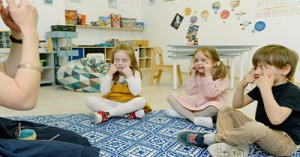Both the Principles and Practices of EYLF place great significance on the nature of child-educator interactions. The following article provides information on What Are Positive Interactions, Developing Positive Interactions, Strategies and more.
Positive interactions form the basis of Secure, Reciprocal and Respectful Relationships (Principle 1) as well as Responsiveness to Children (Practice 2). When educators interact positively with children, it not only leads to greater emotional support and better learning but “can assist children to develop the skills and understandings they need to interact positively with others” as well. Here is more on positive interactions and how educators can develop them in practice.
What Are Positive Interactions
- Good adult-child interactions are respectful, playful, enjoyable, enabling and rewarding. Through positive interactions, the adult:
- Respects all children as individuals with rights.
- builds on children’s abilities, interests, experiences, cultures, and backgrounds.
- Provides for their needs and facilitates them to initiate activities, make choices, and become increasingly independent and responsible.
- Gives children feedback on what they are doing, names and affirms their efforts, celebrate their achievements besides helping them to learn from mistakes and setbacks.
- Takes account of additional needs or supports that children may require in order to participate as fully as possible.
- Establishes and maintains partnerships with children’s families.
Developing Positive Interactions
Be present
Positive interactions start with you being completely ‘present’ in the moment of your interaction with the child. If they are saying something to you, give them your complete attention. Focus on what they are saying, both with their words as well as with voice inflections, rate of speech and body language. For example, when a child is explaining a structure they have built, observe their gestures and facial expressions as a clue for how interested they were in the task.
Respond appropriately
To practice authentic listening, get down to the child’s eye level and use body language to show that you are entirely focused on what they are saying. Interact nonverbally with your learners using small gestures or verbal affirmations, such as nodding your head or offering very brief comments such as “I see”. Vocalizations such as “uh-uh” or “hmm-hmm” are other effective ways of demonstrating positive interaction. Use a pleasant, calm voice and simple language while avoiding dramatic gestures or overenthusiastic expressions – these will probably confuse the child as to the significance of their words or worse, take away the focus from them to you.
Use positive language
When giving instructions to children, use positive words and phrases. This is because negative instructions convey what children are not supposed to do but fall short of telling them what they are supposed to do instead. For example, instructions such as ‘Walk’ instead of ‘Don’t run’, or ‘Feet on the floor rather than ‘Get your feet off the table, state exactly what you expect from children, rather than what is not allowed. Similarly replace negative phrases like ‘No Shouting’, with positive directions, like, “Speak Softly”. In this way, positive language lets the child know exactly what it is they are expected to do and makes for a more cooperative context.
Clarity is key
To ensure that your communication with children is effective, keep instructions simple, direct and above all, say only that which you actually mean. For example, when you want to implement a group time, if you say, ‘Stop running, you have to come and sit on the mat now’, you are packing in three pieces of instruction – stop running, come now and sit on the mat – in just one sentence. What’s more, instead of just ‘come here’, if you use ‘you have to come’, it implies an additional sense of obligation which is unlikely to be fully comprehended by a young child since they are yet to understand the nuances or register of a language. A far better option would be to simply say, ‘Let’s all sit down for a puppet show’ as such a brief, straightforward instruction communicates the message clearly and positively to the children. Similarly an instruction at the lunch table, ‘sit nicely” is vague to the child who does not know what the adult means by ‘nice’; far more effective phrases might be, ‘sit still’, ‘sit quietly’, or ‘use your quiet voice’.
In order to complement clear instructions, you can also use non-verbal language like gestures, facial expressions and tone of voice. However bear in mind that these aspects can be cultural, so you may need to think about the way you use them; also very young children may not have developed the skills to decode gestures like a raised eyebrow. Thus it is best to stick to simple messages that are conveyed clearly and positively.
Offer positive contact
Affectionate behaviour that comfort and encourage children are at the heart of educator-child positive interactions. For example, smile at a child warmly when you catch their eye, sincerely praise their efforts and welcome them lovingly when they arrive in the classroom. Respectful and appropriate physical contact like hugging, holding hands and patting on the back are other ways of nurturing positive attachment between educators and children.
State the expected behaviour
Among the most glaring ways how adults set up children for bad behaviour is by not noticing when a child does something right and instead, promptly pointing out as soon as they slip up. If the desired behaviour is not noticed, how is the child to know what they did right and what they should keep doing? So it is crucial for educators to encourage in case a child displays acceptable behaviour, for example by saying ‘Thank you, Anna, for picking up the blocks off the floor. If we leave them there someone may fall over’.
In case, a child displays an undesirable behaviour, you can take them aside and explain why it is unacceptable; for example, ‘Anna, you left the blocks on the floor, someone may fall over. Please put them away if you have finished playing.
Practice reflective listening
If child appears frustrated, angry or upset, then it is crucial that educators not just listen to them carefully to understand what is going on a child with but use appropriate verbal and non-verbal language to reflect this understanding as well. For example, if a child wants the very same block another child is playing with and as a result, knocks down the latter’s tower, use reflective listening to say something like, “I know you are frustrated because you wanted that block and it is hard when you can’t have what you want, but it is not okay to mess up someone else’s blocks. If you want to continue to play here, you will have to stay away from the other child’s blocks”. With such a strategy, you can show that while you understand that it is normal for a child to feel frustrated when they cannot have something when they want it, it is not okay to interfere or hurt someone else because they are frustrated.
An important aspect of reflective listening is to mirror the child’s words in conversation back to them. For example, if a child says they don’t want to go outside as they are cold, use appropriate body language and say encouragingly, ‘If you feel cold today, maybe you can put on your coat’. For one, this shows to the child that someone is listening to them carefully and additionally, that their anxieties are understood and addressed in a positive manner.
Provide consequences
Sometimes, despite your best efforts at nurturing positive interactions, there may be challenging behaviours in class. If feasible, ignore minor disruptions and practice positive reinforcement as soon as the child demonstrates desirable actions. If a child is mature enough, then show that their actions or choices will result in a particular outcome. For example, If two children are fighting or arguing over the same piece of equipment you might allow the child to make a decision or if they are unable to do so, say that “If you can’t sort out who had the ball first then the ball will be put away”. It is important that a consequence is not viewed by the educator as a threat or as a punishment but rather as an opportunity to let the children or child make a decision, change their behaviour or find a solution.
Be patient
Allow both yourself and your learners, ample time to get the hang of positive interactions. Relationships cannot be built overnight – look for any opportunities that may arise to nurture positive engagement with children in your care. For example, use routines like nappy changing for one-to-one time with babies during which you may play peek-a-boo or sync your voice to their cooing and hum a tune. With toddlers, you can use story reading time to offer support and encourage their sense of wonder and they sit on your lap and you look at pictures together. Work with families to deepen children’s sense of belonging. Do all this regularly and remain consistent in your approach so that children know they can depend on you for guidance and support.
Further Reading
Active Listening - The article provides information on What Active Listening Is, Active Listening Definition, Active Listening Skills Examples and more.
Redirecting Children's Behaviour - The following article provides information on How Redirecting Behaviour Help, Types Of Redirecting Behaviour, Redirecting Behaviour Strategies and more.
Forming Relationships With Children In Childcare - The following article provides information on Why Relationships Matter, Strategies To Implement When Building Relationships, Stages Of Social Development and more.
How To Achieve Quality Area 5 - The following is a list of outcomes under each element within QA5, that can help services identify if they are achieving Quality Area 5. It also includes documentation to support each element. This list can be used as a guide for Self-Assessment purposes and the development of the Quality Improvement Plan.
References:
Belonging, Being, Becoming, ACECQA
Learning Through Interactions, Curriculum Online
What Works, Challenging Behaviours
Planning and Startegies Positive bevahiour, ACECQAA







 As an Educator in Australia, your pay rate falls under the Children’s Services Award 2010. This award states the minimum amount that an employer can
As an Educator in Australia, your pay rate falls under the Children’s Services Award 2010. This award states the minimum amount that an employer can When working as a qualified Early Childhood Teacher (with a university degree) within a service, your rate of pay will come from the Educational Services
When working as a qualified Early Childhood Teacher (with a university degree) within a service, your rate of pay will come from the Educational Services When working as a Diploma Qualified Educator your pay rate is from the Children's Services Award 2010. This Award states your minimum rate of pay
When working as a Diploma Qualified Educator your pay rate is from the Children's Services Award 2010. This Award states your minimum rate of pay When working as a Cert 3 Qualified Educator, your pay rate is from the Children's Services Award 2010. This Award states your minimum rate of
When working as a Cert 3 Qualified Educator, your pay rate is from the Children's Services Award 2010. This Award states your minimum rate of Educational Leaders play a crucial role in their early childhood service by ensuring that the educational program aligns with best practices and supports the holistic
Educational Leaders play a crucial role in their early childhood service by ensuring that the educational program aligns with best practices and supports the holistic In early childhood education and care, ratios are more than a technicality—they are a frontline safeguard. Every child deserves responsive supervision, emotional connection, and developmental
In early childhood education and care, ratios are more than a technicality—they are a frontline safeguard. Every child deserves responsive supervision, emotional connection, and developmental Here’s a comprehensive Mobile Phone and Smart Watch Policy tailored for early childhood education and care (ECEC) services in Australia, aligned with the latest 2025
Here’s a comprehensive Mobile Phone and Smart Watch Policy tailored for early childhood education and care (ECEC) services in Australia, aligned with the latest 2025 With the new national child safety reforms kicking in on 1 September 2025, early childhood services like yours have a real opportunity to lead the
With the new national child safety reforms kicking in on 1 September 2025, early childhood services like yours have a real opportunity to lead the The Sea of Fish Challenge is a national initiative that invites children, educators, families, and communities to create and display fish artworks as a symbol
The Sea of Fish Challenge is a national initiative that invites children, educators, families, and communities to create and display fish artworks as a symbol Across the early childhood education and care sector, educators are sounding the alarm: current staffing ratios are insufficient to deliver safe, meaningful, and developmentally appropriate
Across the early childhood education and care sector, educators are sounding the alarm: current staffing ratios are insufficient to deliver safe, meaningful, and developmentally appropriate


